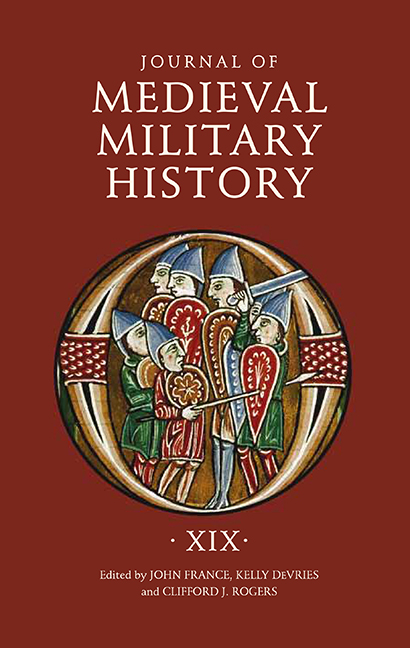Book contents
- Frontmatter
- Contents
- List of Illustrations
- 1 The Battle of Firāḍ: The Day on Which Khālid b. al-Walīd Did [Not] Defeat Both Byzantines and Persians
- 2 A Mislocated Battlefield? Battle Flats: The Battle of Stamford Bridge, 1066
- 3 The Frankish Campaign of 1133–1134 in Northern Syria and the Battle of Qinnasrīn
- 4 Bella Plus Quam Civilia? The Place of Battle in the Context of Civil War under the Anglo-Norman and Angevin Kings, c. 1100–c. 1217
- 5 Edward I’s War on the Continent, 1297–1298: A New Appraisal
- 6 The Earliest European Recipes for “Powder for Guns” (1336 and 1338–c. 1350)
- 7 Bellicose Rhetoric: The Memorable War Speeches of One Aragonese Royal Couple
- 8 Coureurs and Their Role in Late Medieval Warfare
- List of Contributors
- Journal of Medieval Military History 1477–545X
2 - A Mislocated Battlefield? Battle Flats: The Battle of Stamford Bridge, 1066
Published online by Cambridge University Press: 02 June 2021
- Frontmatter
- Contents
- List of Illustrations
- 1 The Battle of Firāḍ: The Day on Which Khālid b. al-Walīd Did [Not] Defeat Both Byzantines and Persians
- 2 A Mislocated Battlefield? Battle Flats: The Battle of Stamford Bridge, 1066
- 3 The Frankish Campaign of 1133–1134 in Northern Syria and the Battle of Qinnasrīn
- 4 Bella Plus Quam Civilia? The Place of Battle in the Context of Civil War under the Anglo-Norman and Angevin Kings, c. 1100–c. 1217
- 5 Edward I’s War on the Continent, 1297–1298: A New Appraisal
- 6 The Earliest European Recipes for “Powder for Guns” (1336 and 1338–c. 1350)
- 7 Bellicose Rhetoric: The Memorable War Speeches of One Aragonese Royal Couple
- 8 Coureurs and Their Role in Late Medieval Warfare
- List of Contributors
- Journal of Medieval Military History 1477–545X
Summary
The Battle of Stamford Bridge, fought 25 September 1066, was a decisive victory for the English led by Harold Godwinson over an invading Norwegian army commanded by Harald Sigurdsson. Although details of the battle have been debated for decades, the location of the battlefield is traditionally believed to have been a large meadow located east of the Derwent River near the town of Stamford Bridge known as Battle Flats. Original written sources that describe the battle do not mention Battle Flats nor is there any archaeological evidence that confirms it as the location of the battle. Despite this lack of evidence, most scholars have based their interpretations and reconstructions of the battle on the premise that the local tradition referencing Battle Flats is correct. This paper will demonstrate why this premise may be incorrect and suggest a more credible location west of the Derwent River at Halifax Meadow that aligns more closely with events as described in English, Anglo-Norman and Scandinavian accounts of the battle.
According to local tradition, the Battle of Stamford Bridge was fought east of the Derwent River in a meadow referred to as Battle Flats. The commonly accepted narrative has the battle beginning in a meadow west of the Derwent River, progressing across Stamford Bridge, where a lone Norwegian defender reportedly held up the entire English army before being killed, and ending at Battle Flats. The dearth of reliable archaeological information has forced scholars to rely primarily on original written sources for reconstructions of the battle. Original sources, however, do not reference the actual location of the battlefield. Rather, as DeVries notes, they are “vague on the topography of the battlefield, indicating only the prominence of the Derwent River, a tributary of the Ouse River, running through the battlefield with a narrow wooden bridge running over it.”
The general acceptance of Battle Flats as the location of the battle appears to have been based on a single line in Manuscript C of The Anglo-Saxon Chronicle. According to the chronicler, “Then Harold, king of the English, moved against them by surprise beyond the bridge, and they clashed together there and were fighting very hard long into the day.” However, this passage may possibly have been misconstrued. As Plummer explains, the phrase “beyond the bridge” must be viewed “from the point of view of the enemy.
- Type
- Chapter
- Information
- Journal of Medieval Military HistoryVolume XIX, pp. 21 - 42Publisher: Boydell & BrewerPrint publication year: 2021

